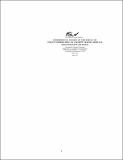Experimental Studies of the Effect of Intent Information on
Author(s)
Barhydt, Richard
DownloadASL-97-3.pdf (1.512Mb)
Metadata
Show full item recordAbstract
Intent information provides knowledge of another aircraft’s current and future trajectory states. Prototype traffic displays were designed for four different levels of intent: Position, Rate, Commanded State, and FMS-Path. The current TCAS Display, which shows altitude rate in addition to current position and altitude, was used as a baseline and represents the lowest level of intent. The Rate, Commanded State, and FMS-Path Displays show increasing levels of intent information using TCAS-like symbology in addition to incorporating a conflict probe and profile view display. An initial experiment was run on the MIT Part Task Flight Simulator in which eight airline pilots flew five traffic scenarios with each of the four displays. Results show that pilots had fewer separation violations and maneuvered earlier with the three intent displays. Separation violations were reduced when pilots maneuvered earlier. A second experiment was run to compare performance between displaying intent information directly and incorporating it into a conflict probe. A different set of eight airline pilots flew four traffic scenarios with the TCAS and Commanded State Displays with and without the conflict probe. Conflict probes with two minute and long range look-ahead times were tested. Displaying conflict bands or showing intent information directly both led to fewer separation violations and earlier avoidance maneuvers than the base TCAS Display. Performance was similar between the two minute and long range look-ahead conflict probes. Pilots preferred all intent displays over the TCAS Display.
Date issued
1997-05Publisher
Internationa
Series/Report no.
ASL-97-3
Keywords
air traffic control, cockpit, Air Transportation